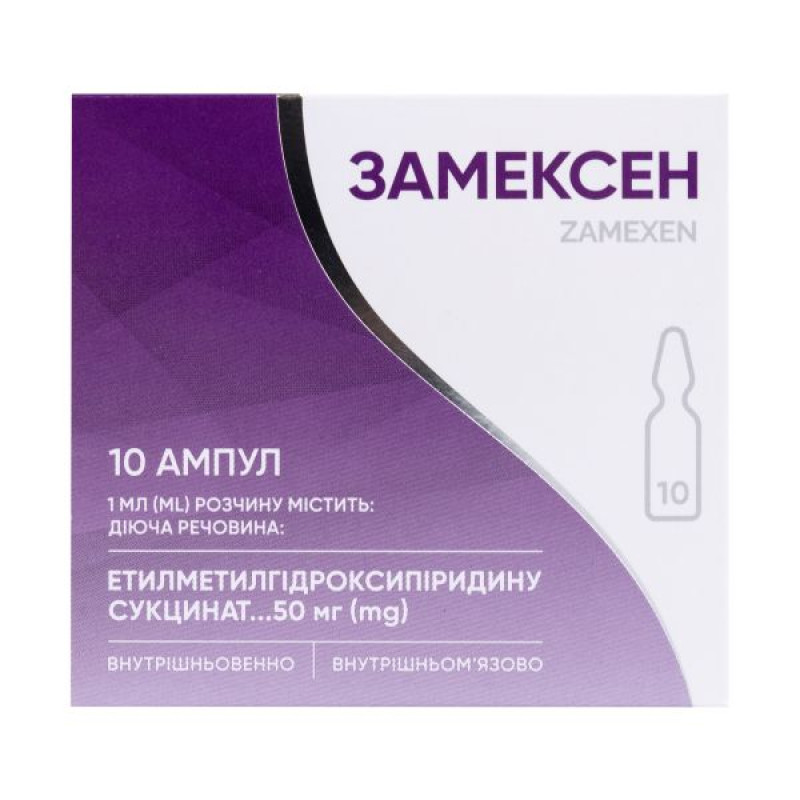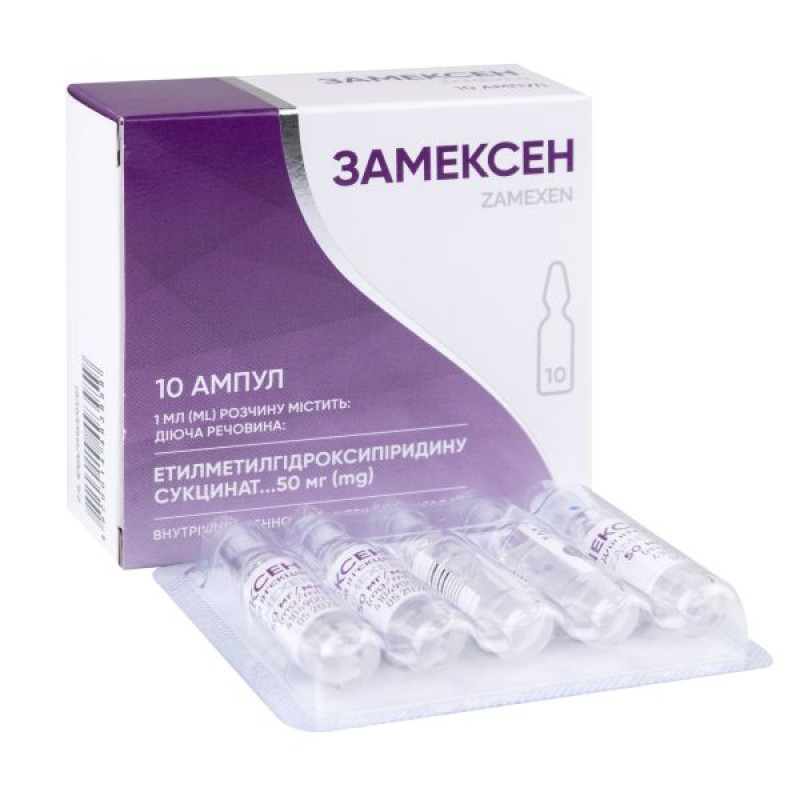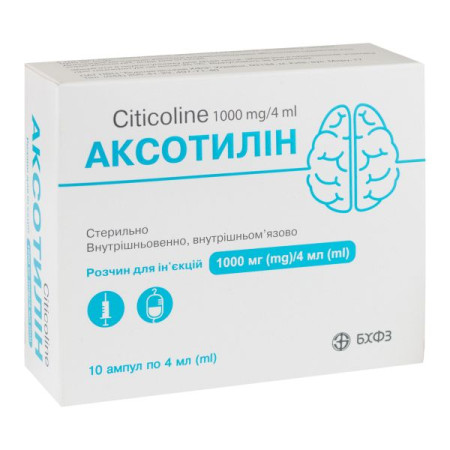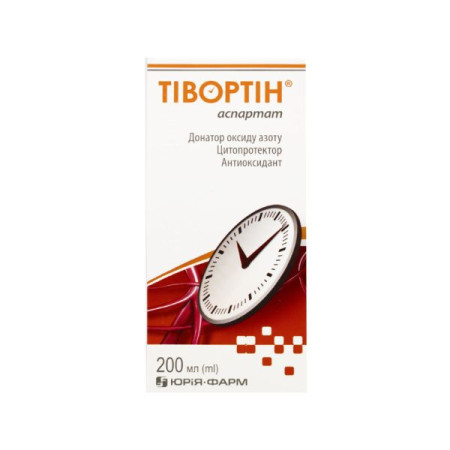Zamexen solution for injection 50 mg/ml ampoule 2 ml No. 10
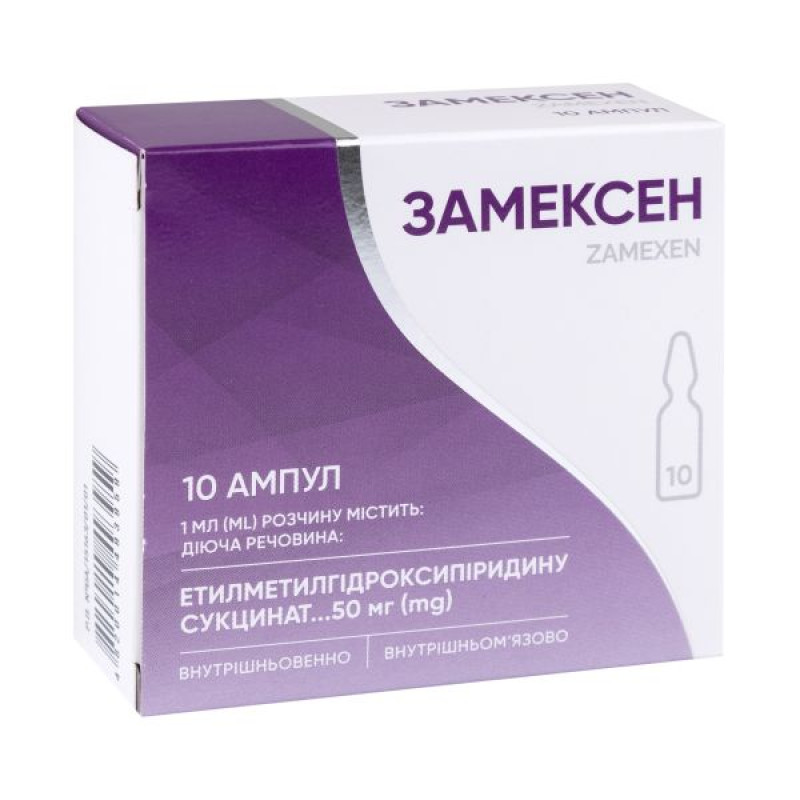
Instructions Zamexen solution for injection 50 mg/ml ampoule 2 ml No. 10
Composition
active ingredient: ethylmethylhydroxypyridine succinate;
1 ml of solution contains ethylmethylhydroxypyridine succinate 50 mg;
Excipients: sodium metabisulfite (E 223), water for injections.
Dosage form
Solution for injection.
Main physicochemical properties: colorless or slightly yellowish transparent liquid.
Pharmacotherapeutic group
Drugs affecting the nervous system. ATX code N07X X.
Pharmacological properties
Pharmacodynamics
Zamexen is an inhibitor of free radical processes, a membrane protector, has antihypoxic, stress-protective, nootropic, anticonvulsant and anxiolytic effects. The drug increases the body's resistance to the effects of various harmful factors, oxygen-dependent pathological conditions (shock, hypoxia and ischemia, cerebral circulation disorders, intoxication with alcohol and antipsychotics (neuroleptics)).
Zamexen improves cerebral metabolism and blood supply to the brain, improves microcirculation and rheological properties of blood, reduces platelet aggregation. Stabilizes membrane structures of blood cells (erythrocytes and platelets) during hemolysis. Has a hypolipidemic effect, reduces the content of total cholesterol and low-density lipoproteins (LDL). Reduces enzymatic toxemia and endogenous intoxication in acute pancreatitis.
The mechanism of action of the drug is due to its antioxidant and membrane-protective effect. It inhibits lipid peroxidation, increases the activity of superoxide dismutase, increases the lipid-protein ratio, reduces membrane viscosity, increases its fluidity. Modulates the activity of membrane-bound enzymes (calcium-independent phosphodiesterase, adenylate cyclase, acetylcholinesterase), receptor complexes (benzodiazepine, gamma-aminobutyric acid (GABA), acetylcholine), which increases their ability to bind to ligands, contributes to the preservation of the structural and functional organization of biomembranes, the transport of neurotransmitters and the improvement of synaptic transmission. Zamexen increases the content of dopamine in the brain. Causes increased compensatory activation of aerobic glycolysis and a decrease in the degree of inhibition of oxidative processes in the Krebs cycle under conditions of hypoxia with an increase in the content of adenosine triphosphate (ATP) and creatine phosphate, activation of energy-synthesizing functions of mitochondria, stabilization of cell membranes.
Zamexen normalizes metabolic processes in ischemic myocardium, reduces the area of necrosis, restores and improves electrical activity and myocardial contractility, and also increases coronary blood flow in the ischemic area, reduces the effects of reperfusion syndrome in acute coronary insufficiency. Increases the antianginal activity of nitro drugs. Zamexen helps preserve retinal ganglion cells and optic nerve fibers in progressive neuropathy, the consequences of which are chronic ischemia and hypoxia. Improves the functional activity of the retina and optic nerve, increases visual acuity.
Pharmacokinetics
When administered intramuscularly, the drug is detected in the blood plasma within 4 hours after administration. The time to reach the maximum concentration is 0.45-0.5 hours. The maximum concentration at doses of 400-500 mg is 3.5-4.0 μg/ml. Zamexen quickly passes from the bloodstream into organs and tissues and is quickly eliminated from the body. The drug is excreted from the body with urine, mainly in the glucuronide conjugated form and in small quantities in unchanged form.
Indication
Acute cerebral circulation disorders; traumatic brain injury, consequences of traumatic brain injuries; dyscirculatory encephalopathy; vegetative dystonia syndrome; mild cognitive disorders of atherosclerotic genesis; anxiety disorders in neurotic and neurosis-like conditions; acute myocardial infarction (from the first day) as part of complex therapy; primary open-angle glaucoma of various stages as part of complex therapy; relief of withdrawal syndrome in alcoholism with a predominance of neurosis-like and vegetative-vascular disorders; acute intoxication with antipsychotic drugs; acute purulent-inflammatory processes in the abdominal cavity (acute necrotic pancreatitis, peritonitis) as part of complex therapy.
Contraindication
Acute hepatic or renal failure, increased individual sensitivity to the drug, childhood, pregnancy, breastfeeding.
Interaction with other medicinal products and other types of interactions
Zamexen enhances the effect of benzodiazepine anxiolytics, anticonvulsants (carbamazepine), antiparkinsonian drugs (levodopa); reduces the toxic effect of ethyl alcohol.
Application features
In some cases, especially in predisposed patients, in patients with bronchial asthma with increased sensitivity to sulfites, severe hypersensitivity reactions may develop.
The medicine contains sodium metabisulfite, which may cause bronchospasm.
After completion of parenteral administration, it is recommended to continue using the drug orally in tablet form to maintain the achieved effect.
Ability to influence reaction speed when driving vehicles or other mechanisms
During the treatment period, caution should be exercised when driving or operating complex machinery, given the likelihood of side effects that may affect reaction speed and ability to concentrate.
Use during pregnancy or breastfeeding
Zamexen is contraindicated during pregnancy and breastfeeding.
Method of administration and doses
Zamexen is administered intramuscularly or intravenously (jet, drip). Doses are selected individually. When administered by infusion, the drug should be diluted in saline (200 ml). Adults begin treatment with a dose of 50-100 mg 1-3 times a day, gradually increasing the dose until a therapeutic effect is obtained. Zamexen is administered slowly by jet over 5-7 minutes, drip - at a rate of 40-60 drops per minute. The maximum daily dose should not exceed 1200 mg.
In acute cerebrovascular accidents, Zamexen is prescribed to adults in complex therapy in the first 2-4 days intravenously by jet or drip 200-500 mg 1 time per day, then intramuscularly 200-500 mg 2-3 times per day. The treatment period is 14 days.
In case of traumatic brain injury and consequences of traumatic brain injury, Zamexen is used for 10-15 days by intravenous drip injection of 200-500 mg 2-4 times a day.
In case of dyscirculatory encephalopathy in the decompensation phase, Zamexen should be administered intravenously by jet or drip at a dose of 200-500 mg 1-2 times a day for 14 days. Then the drug is administered intramuscularly at 100-250 mg per day for the next 2 weeks.
For course prevention of dyscirculatory encephalopathy, the drug is administered intramuscularly to adults at 200-250 mg 2 times a day for 10-14 days.
For mild cognitive impairment in elderly patients and anxiety states, the drug is administered intramuscularly at a dose of 100-300 mg per day for 14-30 days.
In acute myocardial infarction, Zamexen is administered intravenously or intramuscularly for 14 days against the background of traditional myocardial infarction therapy, which includes nitrates, beta-blockers, angiotensin-converting enzyme (ACE) inhibitors, thrombolytics, anticoagulants and antiplatelet agents, as well as symptomatic agents according to indications. In the first 5 days, to achieve maximum effect, intravenous administration of Zamexen is desirable, in the next 9 days, intramuscular administration of Zamexen is possible. Intravenous administration of Zamexen is carried out by drip infusion, slowly (to avoid side effects), with 0.9% sodium chloride solution or 5% dextrose (glucose) solution in a volume of 100-150 ml for 30-90 minutes. If necessary, slow jet injection of Zamexen is possible for at least 5 minutes.
Zamexen is administered (intravenously or intramuscularly) 3 times a day, every 8 hours. The daily therapeutic dose is 6-9 mg per kilogram of body weight per day, a single dose is 2-3 mg/kg of body weight. The maximum daily dose should not exceed 800 mg, a single dose is 250 mg.
In open-angle glaucoma of various stages, Zamexen is used as part of complex therapy intramuscularly at 100-300 mg per day, 1-3 times a day, for 14 days.
For alcohol withdrawal syndrome, Zamexen is administered at a dose of 200-500 mg intravenously or intramuscularly 2-3 times a day or intravenously drip 1-2 times a day for 5-7 days.
In acute intoxication with antipsychotic drugs, the drug is administered intravenously to adults at a dose of 200-500 mg per day for 7-14 days.
In acute purulent-inflammatory processes of the abdominal cavity (acute necrotic pancreatitis, peritonitis), the drug is prescribed on the first day both in the preoperative and postoperative periods. Doses depend on the form and severity of the disease, the prevalence of the process, and the clinical course. The drug should be discontinued gradually, only after a stable positive clinical and laboratory effect. In acute edematous (interstitial) pancreatitis, Zamexen is prescribed to adults 200-500 mg 3 times a day intravenously drip (with isotonic sodium chloride solution) and intramuscularly. Mild severity: 100-200 mg 3 times a day intravenously drip (with isotonic sodium chloride solution) and intramuscularly. Moderate severity: adults - 200 mg 3 times a day intravenously drip (with isotonic sodium chloride solution). Severe course: in pulse dosing 800 mg on the first day with a double injection; then - 200-500 mg 2 times a day with a gradual decrease in the daily dose. Very severe course: in the initial dose of 800 mg per day until stable relief of the manifestation of pancreatogenic shock, after stabilization of the condition - 300-500 mg 2 times a day intravenously drip (with isotonic sodium chloride solution) with a gradual decrease in the daily dose.
Children
Strictly controlled clinical studies of the safety of the drug in children have not been conducted, therefore Zamexen is contraindicated for use in this category of patients.
Overdose
Treatment: due to low toxicity, overdose is unlikely. Treatment is usually not required, symptoms resolve on their own within 24 hours. In case of severe manifestations, supportive and symptomatic treatment is performed.
Adverse reactions
To avoid adverse reactions, it is recommended to adhere to the dosage regimen and rate of administration of the drug. The frequency of side effects was determined according to the classification of the World Health Organization (WHO): very common (≥ 10%); common (≥ 1%, ≤ 10%); uncommon (≥ 0.1%, ≤ 1%); rare (≥ 0.01%, ≤ 0.1%); very rare (≤ 0.01%); frequency unknown (frequency cannot be estimated from the available data).
On the part of the immune system: very rarely - anaphylactic shock, angioedema, urticaria; frequency unknown - allergic reactions, hyperemia, severe hypersensitivity reactions are possible.
Mental disorders: very rarely - drowsiness; frequency unknown - sleep disturbance, feeling of anxiety, emotional reactivity.
Cardiovascular system: frequency unknown - palpitations, tachycardia.
From the nervous system: very rarely - headache, dizziness (may be associated with an excessively high rate of administration and be short-term); frequency unknown - impaired coordination, tremor.
Vascular: very rarely - decreased blood pressure, increased blood pressure (may be associated with an excessively high rate of administration and be short-term).
On the part of the respiratory system, chest organs and mediastinum: very rarely - dry cough, sore throat, chest discomfort, difficulty breathing (may be associated with an excessively high rate of administration and be of a short-term nature); frequency unknown - bronchospasm.
Gastrointestinal: very rarely - dry mouth, nausea, bad breath, metallic taste in the mouth; frequency unknown - dyspeptic disorders, diarrhea.
Skin and subcutaneous tissue disorders: very rarely - itching, rash, facial flushing; frequency unknown - distal hyperhidrosis.
General disorders and administration site conditions: very rare – feeling of warmth; frequency unknown – changes at the injection site.
Against the background of long-term administration of the drug, the following side effects may occur: flatulence, weakness, peripheral edema.
Expiration date
2 years.
Storage conditions
Store in original packaging at a temperature not exceeding 25 ° C. Keep out of the reach of children.
Packaging
2 ml in an ampoule; 10 ampoules in a cardboard pack.
Vacation category
According to the recipe.
Producer
Private Joint-Stock Company "Lekhim-Kharkiv".
Location of the manufacturer and its business address
Ukraine, 61115, Kharkiv region, Kharkiv city, Severyna Pototskoho street, building 36.
There are no reviews for this product.
There are no reviews for this product, be the first to leave your review.
No questions about this product, be the first and ask your question.







